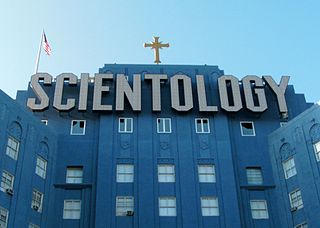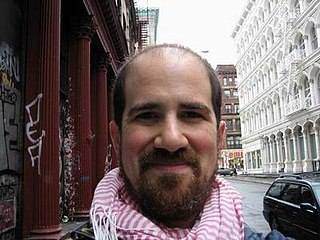
There are a number of disputes concerning the Church of Scientology's attempts to suppress material critical of Scientology and the organization on the Internet, utilizing various methods – primarily lawsuits and legal threats, as well as front organizations. In late 1994, the organization began using various legal tactics to stop distribution of unpublished documents written by L. Ron Hubbard. The organization has often been accused of barratry through the filing of SLAPP suits. The organization's response is that its litigious nature is solely to protect its copyrighted works and the unpublished status of certain documents.
The Great Renaming was a restructuring of Usenet newsgroups that took place in 1987. B News maintainer and UUNET founder Rick Adams is generally considered to be the initiator of the Renaming.
alt.binaries.slack is a Usenet newsgroup created for the purpose of posting pictures, sounds, and utilities related to the Church of the SubGenius, making them available for everyone to see and hear. Because the Church of the SubGenius is well known for encouraging sick and twisted humor, the newsgroup is also home to artists who post humorous artwork of all sorts. A fair amount of the pictures on alt.binaries.slack are adult-oriented, and may be considered offensive by some viewers. The denizens of the newsgroup state that they enjoy deliberately offending those who are too easily offended.

Sporgery is the disruptive act of posting a flood of articles to a Usenet newsgroup, with the article headers falsified so that they appear to have been posted by others. The word is a portmanteau of spam and forgery, coined by German software developer, and critic of Scientology, Tilman Hausherr.
Eternal September or the September that never ended was a cultural phenomenon during a period beginning around late 1993 and early 1994, when Internet service providers began offering Usenet access to many new users. Prior to this, the only sudden changes in the volume of new users of Usenet occurred each September, when cohorts of university students would gain access to it for the first time. The periodic flood of new users overwhelmed the existing culture for online forums and the ability to enforce existing norms. AOL began their Usenet gateway service in March 1994, leading to a constant stream of new users. Hence, from the early Usenet hobbyist point of view, the influx of new users that began in September 1993 appeared to be endless.
Etoy is a European digital art group formed in 1994. It has won several international awards including the Prix Ars Electronica in 1996. Their main slogan is: "leaving reality behind."
The Prix Ars Electronica is one of the best known and longest running yearly prizes in the field of electronic and interactive art, computer animation, digital culture and music. It has been awarded since 1987 by Ars Electronica.

UBERMORGEN.COM is a Swiss-Austrian-American artist duo founded in 1995 and consisting of lizvlx and Luzius Bernhard. They live and work in Basel, S-chanf near St. Moritz and in Vienna, where both are professors at the University of Applied Arts Vienna.

Beginning around 1991, the creator of the television series Babylon 5, J. Michael Straczynski, participated in a number of Internet venues to discuss elements of his work with his fans, including the rec.arts.sf.tv.babylon5 Usenet newsgroup, where he continued to communicate as late as March 2007. This flow of information and feedback had a substantial impact on Babylon 5, as well as Straczynski's other shows and his fan base. This interaction pre-dated the coining of the term "blog", but is functionally similar.

Gridcosm is a collaborative art project of the online art collective SITO, in which artists from around the world contribute images to a compounding series of graphical squares. Each level of Gridcosm is made up of nine square images arranged into a 3-by-3 grid. The middle image is a one-third size version of the previous level. Artists add images around that center image until a new 3-by-3 grid is completed, then that level itself shrinks and becomes the "seed" for the next level. This process creates an ever-expanding tunnel of images, the newest level a direct result of the previous level which is a result of the previous level and so on.
Eyebeam is a not-for-profit art and technology center in New York City, founded by John Seward Johnson III with co-founders David S. Johnson and Roderic R. Richardson.

Golan Levin is an American new media artist, composer, performer and engineer interested in developing artifacts and events which explore supple new modes of reactive expression.

Bernard Dumaine is a French artist best known for his work in photorealism and surrealism styles and for his background designs for television cartoons. He works in a variety of media, including oil paints, acrylic paints, graphite pencil, digital painting, digital collage, and video.

Zachary Lieberman is an American new media artist, designer, computer programmer, and educator.

Usenet, USENET, or, "in full", User's Network, is a worldwide distributed discussion system available on computers. It was developed from the general-purpose Unix-to-Unix Copy (UUCP) dial-up network architecture. Tom Truscott and Jim Ellis conceived the idea in 1979, and it was established in 1980. Users read and post messages to one or more topic categories, known as newsgroups. Usenet resembles a bulletin board system (BBS) in many respects and is the precursor to the Internet forums that have become widely used. Discussions are threaded, as with web forums and BBSes, though posts are stored on the server sequentially.
Tom Corby and Gavin Baily (1970) are two London based artists who work collaboratively using public domain data, climate models, satellite imagery and the Internet. Recent work has focused on climate change and its relationship to technology and has involved collaborations with scientists working at the British Antarctic Survey. Corby and Baily are founder members of the Atmospheric Research Collective, an experimental artist group which works in collaboration with climate scientists. For an overview of recent works see "An interview with artist and writer Tom Corb y".

Ars Electronica Linz GmbH is an Austrian cultural, educational and scientific institute active in the field of new media art, founded in Linz in 1979. It is based at the Ars Electronica Center (AEC), which houses the Museum of the Future, in the city of Linz. Ars Electronica's activities focus on the interlinkages between art, technology and society. It runs an annual festival, and manages a multidisciplinary media arts R&D facility known as the Futurelab. It also confers the Prix Ars Electronica awards.
The Meow Wars were an early example of a flame war sent over Usenet which began in 1996 and ended circa 1998. Its participants were known as "Meowers". The war was characterized by posters from one newsgroup "crapflooding", or posting a large volume of nonsense messages, to swamp on-topic communication in other groups. Ultimately, the flame war affected many boards, with Roisin Kiberd writing in Motherboard, a division of Vice, that esoteric Internet vocabulary was created as a result of the Meow Wars.









